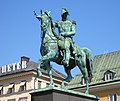Bengt Erland Fogelberg

Bengt Erland Fogelberg , also Benedict Fogelberg (born August 8, 1786 in Gothenburg , † December 22, 1854 in Trieste ) was a Swedish sculptor .
Life
Fogelberg gained his first technical experience as his father's apprentice in the brass foundry trade . From 1803 he worked for a few years for the Stockholm court chaser Rung. He later gave up the craft and devoted himself to art. The Stockholm Art Academy awarded him their highest medal in 1811. A scholarship enabled him to stay in Paris in 1820; In 1821 he took up his permanent residence in Rome , where he soon made a name for himself through hard work. He was one of the first who dared to depict the Nordic gods in plastic form, and in fact, influenced by Bertel Thorvaldsen , he transferred the ancient forms to the Nordic world. No matter how much his talent is to be recognized, he has not succeeded in convincingly realizing the swaying outlines of those gods' figures.
After being the guest of honor at the unveiling of three of his major works in Sweden in 1854, Fogelberg died on December 22nd, 1854, in Trieste while he was returning to Rome.
Works
The museum to Stockholm has the statues of Odin , Thor , Mercury the Argus killing , Venus and Apollo Citharoedus . The cities of Bremen (original; erected 1856) and Gothenburg (second cast; erected 1854) received a statue of King Gustav II Adolf . Together with Johan Niclas Byström , Fogelberg completed the colossal statues of the kings Gustav II. Adolf, Karl X. Gustav , Karl XI. (Sweden) , Charles XII. (Sweden) , Charles XIII. (Sweden) and Karl XIV. Johann (Sweden) in the castle in Stockholm.
Stockholm:
equestrian statue of King
Karl XIV. Johann (Sweden)
at the harborBremen:
Gustav II. Adolf statueUpsala:
Gustav Vasa
Monument
literature
- Bengt Erland Fogelberg . In: Ulrich Thieme (Hrsg.): General Lexicon of Fine Artists from Antiquity to the Present . Founded by Ulrich Thieme and Felix Becker . tape 11 : Erman-Fiorenzo . EA Seemann, Leipzig 1915, p. 138 ( Textarchiv - Internet Archive ).
- Fogelberg, Bengt Erland . In: Herman Hofberg, Frithiof Heurlin, Viktor Millqvist, Olof Rubenson (eds.): Svenskt biografiskt handlexikon . 2nd Edition. tape 1 : A-K . Albert Bonniers Verlag, Stockholm 1906, p. 344-345 (Swedish, runeberg.org ).
Web links
| personal data | |
|---|---|
| SURNAME | Fogelberg, Bengt Erland |
| ALTERNATIVE NAMES | Fogelberg, Benedict; Fogelberg, Benedict |
| BRIEF DESCRIPTION | Swedish sculptor |
| DATE OF BIRTH | August 8, 1786 |
| PLACE OF BIRTH | Gothenburg |
| DATE OF DEATH | December 22, 1854 |
| Place of death | Trieste |




